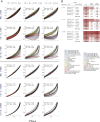Cleaning up the record on the maximal information coefficient and equitability
- PMID: 25139972
- PMCID: PMC4143006
- DOI: 10.1073/pnas.1408920111
Cleaning up the record on the maximal information coefficient and equitability
Conflict of interest statement
The authors declare no conflict of interest.
Figures

Comment in
-
Reply to Reshef et al.: Falsifiability or bust.Proc Natl Acad Sci U S A. 2014 Aug 19;111(33):E3364. doi: 10.1073/pnas.1410317111. Proc Natl Acad Sci U S A. 2014. PMID: 25275168 Free PMC article. No abstract available.
Comment on
-
Equitability, mutual information, and the maximal information coefficient.Proc Natl Acad Sci U S A. 2014 Mar 4;111(9):3354-9. doi: 10.1073/pnas.1309933111. Epub 2014 Feb 18. Proc Natl Acad Sci U S A. 2014. PMID: 24550517 Free PMC article.
References
-
- Reshef DN, Reshef YA, Mitzenmacher M, Sabeti PC. 2013. Equitability analysis of the maximal information coefficient with comparisons. arXiv:1301.6314v2 [cs.LG]
Publication types
MeSH terms
Grants and funding
LinkOut - more resources
Full Text Sources
Other Literature Sources
Medical

